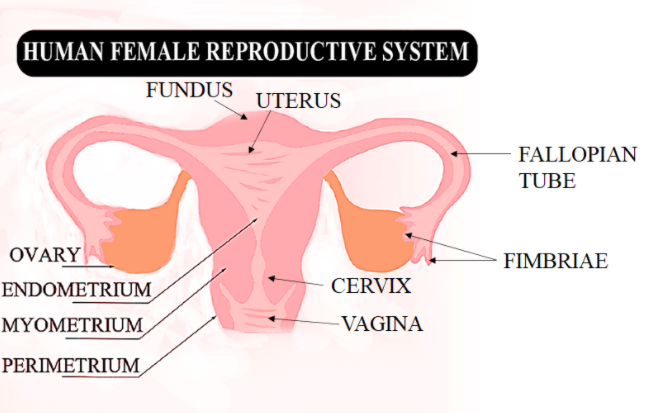
Draw a labelled diagram of a female reproductive system.
Answer
577.8k+ views
Hint: The reproductive system of a female is immature at birth and develops at maturity which is made up of the internal and external sex organs that have a role in the reproduction of new offspring.
Complete answer:

The reproductive system has a pair of ovaries, uterus, fallopian tubes, cervix, and vagina.
Ovary- It is located in the upper pelvic cavity and releases one egg cell once a month simultaneously. There is one pair of ovaries shaped like an almond of size around 2 cm to 3.5 cm wide and 1 cm thick. The ovary also secretes female hormones i.e. estrogen and progesterone.
Fimbriae- these are connected to the ovary and are small, finger-like projections at the end of the fallopian tubes, through which eggs move from the ovaries to the uterus.
Fallopian tubes- or uterine tubes or salpinges (singular salpinx), are tubes that stretch from the uterus to the ovaries and contains 3 parts: isthmus (closest to the uterus), ampulla (increases in diameter and is the most common site for fertilization), and final segment infundibulum. The fertilized egg passes through the tubes from the ovaries of female mammals to the uterus.
Uterus- it is a muscular organ above the vagina and between the bladder and rectum. The fetus or unborn child develops here and the walls of the uterus contract to push out the fetus during childbirth.
Endometrium and myometrium- The innermost layer is the endometrium which thickens each month for the preparation of an embryo and sheds in the menstrual period if fertilization does not occur. The middle layer of the uterine wall, consisting mainly of uterine smooth muscle cells is myometrium, it helps in supporting stromal and vascular tissue, and mainly induces uterine contractions.
Cervix and fundus- Cervix is a canal connecting the vagina and uterus and is the neck of the uterus that extends downward to the vagina. The sperm or the infant passes through here. The fundus is the top portion that is opposite of the cervix. Fundal height is usually measured during pregnancy from the top of the pubic bone to determine growth rates.
Vagina- is an elastic and muscular canal and the place where sperm are usually ejaculated during sexual intercourse. The vagina is the birth canal from where the developed baby is delivered out of the female.
Note: The external female reproductive organs are known as the vulva and are the openings for the urethra and vagina. It includes the clitoris and two pairs of labia. The vulva is lubricated by the Secretions from Bartholin’s glands near the vagina opening.
Complete answer:

The reproductive system has a pair of ovaries, uterus, fallopian tubes, cervix, and vagina.
Ovary- It is located in the upper pelvic cavity and releases one egg cell once a month simultaneously. There is one pair of ovaries shaped like an almond of size around 2 cm to 3.5 cm wide and 1 cm thick. The ovary also secretes female hormones i.e. estrogen and progesterone.
Fimbriae- these are connected to the ovary and are small, finger-like projections at the end of the fallopian tubes, through which eggs move from the ovaries to the uterus.
Fallopian tubes- or uterine tubes or salpinges (singular salpinx), are tubes that stretch from the uterus to the ovaries and contains 3 parts: isthmus (closest to the uterus), ampulla (increases in diameter and is the most common site for fertilization), and final segment infundibulum. The fertilized egg passes through the tubes from the ovaries of female mammals to the uterus.
Uterus- it is a muscular organ above the vagina and between the bladder and rectum. The fetus or unborn child develops here and the walls of the uterus contract to push out the fetus during childbirth.
Endometrium and myometrium- The innermost layer is the endometrium which thickens each month for the preparation of an embryo and sheds in the menstrual period if fertilization does not occur. The middle layer of the uterine wall, consisting mainly of uterine smooth muscle cells is myometrium, it helps in supporting stromal and vascular tissue, and mainly induces uterine contractions.
Cervix and fundus- Cervix is a canal connecting the vagina and uterus and is the neck of the uterus that extends downward to the vagina. The sperm or the infant passes through here. The fundus is the top portion that is opposite of the cervix. Fundal height is usually measured during pregnancy from the top of the pubic bone to determine growth rates.
Vagina- is an elastic and muscular canal and the place where sperm are usually ejaculated during sexual intercourse. The vagina is the birth canal from where the developed baby is delivered out of the female.
Note: The external female reproductive organs are known as the vulva and are the openings for the urethra and vagina. It includes the clitoris and two pairs of labia. The vulva is lubricated by the Secretions from Bartholin’s glands near the vagina opening.
Recently Updated Pages
A man running at a speed 5 ms is viewed in the side class 12 physics CBSE

State and explain Hardy Weinbergs Principle class 12 biology CBSE

Which of the following statements is wrong a Amnion class 12 biology CBSE

Two Planoconcave lenses 1 and 2 of glass of refractive class 12 physics CBSE

The compound 2 methyl 2 butene on reaction with NaIO4 class 12 chemistry CBSE

Bacterial cell wall is made up of A Cellulose B Hemicellulose class 12 biology CBSE

Trending doubts
What are the major means of transport Explain each class 12 social science CBSE

Which are the Top 10 Largest Countries of the World?

Draw a labelled sketch of the human eye class 12 physics CBSE

State the principle of an ac generator and explain class 12 physics CBSE

Sketch the electric field lines in case of an electric class 12 physics CBSE

Give 10 examples of unisexual and bisexual flowers




